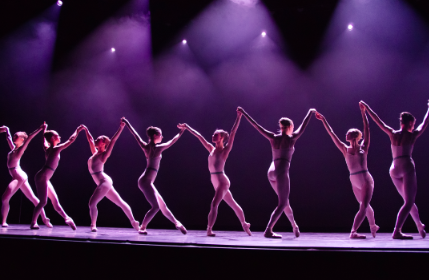
New York City's Joyce Theater is a lovely venue, intimate and uncluttered. It's small enough to be a realistic option for touring regional ballet companies. But sometimes it feels as if these modest troupes are coming to the Joyce to audition for New York itself. Will they cut it in the big, bad, cynical city?
You want to root for them -- especially a company as earnest and well-mannered as Ballet Arizona, which performed at the Joyce last week. There's not a bit of slickness to this group. They're quite uncool, actually, which is just what makes them lovable. Dance to "Twinkle, Twinkle, Little Star," as they did in the opening section of director Ib Andersen's Play? Sure they will -- against a backdrop of twinkle lights to boot -- without so much as a wink.
Since becoming artistic director in 2000, Andersen has transformed Ballet Arizona from a sleepy, amateurish group into a well-respected company. He brought some serious credentials to the job: He was the youngest principal dancer in the Royal Danish Ballet's history, and then spent 10 years dancing for George Balanchine at New York City Ballet. You can see facets of both the Danish (Bournonville) and Balanchine styles in BA's well-trained crop of dancers: Bournonville's clean, fleet footwork, Balanchine's emphasis on anticipating, rather than following, the music.
Play, a full-evening ballet, is made up of a series of vignettes. None of them reveal much about Andersen's own voice as a choreographer. Instead, he dutifully pays tribute to the artists who shaped his own career, Balanchine in particular. That's not a terrible thing. Andersen did his homework well. One of the most haunting sections of Play is a dance for 11 women (set to Benjamin Britten's Prelude and Fugue for 18-part String Orchestra, Op. 29) that all but quotes Balanchine's Symphony in Three Movements, down to the women's white belted leotards. But when you see them line up diagonally across the stage, as they do at the opening of Symphony, you get a little shiver of pleasure. Balanchine would have liked this.
 Ballet Arizona in Play. Photo by Kyle Froman.
Ballet Arizona in Play. Photo by Kyle Froman.
Play covers a lot of ground before intermission. It goes from Mozart to Britten to Arvo Pärt, and from the sweetness of "Twinkle, Twinkle" to an erotic pas de deux for Astrit Zejnati and the enigmatic Natalia Magnicaballi. This duet, which closes the first half, is the weakest part of the work. It's a bit of a shock to the system, after the politeness of the preceding numbers, to see the two dancers in their underwear. But that seems to be the dance's only function. Nakedness switches Andersen into contemporary mode, and he's not comfortable there. The partnering is muddy, and there's too much of it. Magnicaballi barely gets to stand unassisted.
After intermission, things take a turn for the delightful. The second half of the ballet is set to Stravinsky (Suite no. 2 and Pulcinella Suite), and his spiky rhythms enliven the whole company. There are a few hammy false notes -- I could do without the group of jester-like nyuk-nyuk guys -- but the choreography is engaging and musically acute. Sometimes, it's finer than that. In one fascinating section, Andersen has five couples dance a pas de deux in unison. We see them act out the sustained drama of courtship -- will they or won't they? -- together. What would have been intimate moments become public events.
Andersen is a fine craftsman, if not a magician. And his dancers -- particularly Magnicaballi and the polished Paola Hartley -- are appealing performers, if not world-class artists. The whole group seems determined to do things right. Play isn't groundbreaking stuff, but it shows a commitment to real, difficult, substantial dancing. That's not always cool. But it is always honorable.
--------
A former dancer and choreographer, Margaret Fuhrer is an associate editor at Dance Spirit and Pointe magazines and a contributing editor at Dance Teacher magazine.